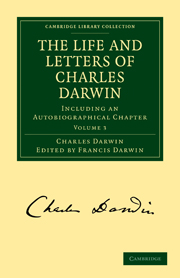Book contents
- Frontmatter
- Contents
- CHAPTER I THE SPREAD OF EVOLUTION. ‘VARIATION OF ANIMALS AND PLANTS’—1863–1866
- CHAPTER II THE PUBLICATION OF THE ‘VARIATION OF ANIMALS AND PLANTS UNDER DOMESTICATION’—JAN. 1867–JUNE 1868
- CHAPTER III WORK ON ‘MAN’—1864–1870
- CHAPTER IV THE PUBLICATION OF THE ‘DESCENT OF MAN.’ THE ‘EXPRESSION OF THE EMOTIONS’—1871–1873
- CHAPTER V MISCELLANEA, INCLUDING SECOND EDITIONS OF ‘CORAL REEFS,’ THE ‘DESCENT OF MAN,’ AND THE ‘VARIATION OF ANIMALS AND PLANTS’—1874–1875
- CHAPTER VI MISCELLANEA (continued). A REVIVAL OF GEOLOGICAL WORK—THE BOOK ON EARTHWORMS—LIFE OF ERASMUS DARWIN—MISCELLANEOUS LETTERS—1876–1882
- BOTANICAL LETTERS
- CHAPTER VII FERTILISATION OF FLOWERS—1839–1880
- CHAPTER VIII THE ‘EFFECTS OF CROSS- AND SELF-FERTILISATION IN THE VEGETABLE KINGDOM’—1866–1877
- CHAPTER IX ‘DIFFERENT FORMS OF FLOWERS ON PLANTS OF THE SAME SPECIES’—1860–1878
- CHAPTER X CLIMBING AND INSECTIVOROUS PLANTS—1863–1875
- CHAPTER XI THE ‘POWER OF MOVEMENT IN PLANTS’—1878–1881
- CHAPTER XII MISCELLANEOUS BOTANICAL LETTERS—1873–1882
- CHAPTER XIII CONCLUSION
- APPENDICES
- INDEX
CHAPTER IX - ‘DIFFERENT FORMS OF FLOWERS ON PLANTS OF THE SAME SPECIES’—1860–1878
Published online by Cambridge University Press: 29 August 2010
- Frontmatter
- Contents
- CHAPTER I THE SPREAD OF EVOLUTION. ‘VARIATION OF ANIMALS AND PLANTS’—1863–1866
- CHAPTER II THE PUBLICATION OF THE ‘VARIATION OF ANIMALS AND PLANTS UNDER DOMESTICATION’—JAN. 1867–JUNE 1868
- CHAPTER III WORK ON ‘MAN’—1864–1870
- CHAPTER IV THE PUBLICATION OF THE ‘DESCENT OF MAN.’ THE ‘EXPRESSION OF THE EMOTIONS’—1871–1873
- CHAPTER V MISCELLANEA, INCLUDING SECOND EDITIONS OF ‘CORAL REEFS,’ THE ‘DESCENT OF MAN,’ AND THE ‘VARIATION OF ANIMALS AND PLANTS’—1874–1875
- CHAPTER VI MISCELLANEA (continued). A REVIVAL OF GEOLOGICAL WORK—THE BOOK ON EARTHWORMS—LIFE OF ERASMUS DARWIN—MISCELLANEOUS LETTERS—1876–1882
- BOTANICAL LETTERS
- CHAPTER VII FERTILISATION OF FLOWERS—1839–1880
- CHAPTER VIII THE ‘EFFECTS OF CROSS- AND SELF-FERTILISATION IN THE VEGETABLE KINGDOM’—1866–1877
- CHAPTER IX ‘DIFFERENT FORMS OF FLOWERS ON PLANTS OF THE SAME SPECIES’—1860–1878
- CHAPTER X CLIMBING AND INSECTIVOROUS PLANTS—1863–1875
- CHAPTER XI THE ‘POWER OF MOVEMENT IN PLANTS’—1878–1881
- CHAPTER XII MISCELLANEOUS BOTANICAL LETTERS—1873–1882
- CHAPTER XIII CONCLUSION
- APPENDICES
- INDEX
Summary
[The volume bearing the above title was published in 1877, and was dedicated by the author to Professor Asa Gray, “as a small tribute of respect and affection.” It consists of certain earlier papers re-edited, with the addition of a quantity of new matter. The subjects treated in the book are:—
(i.) Heterostyled Plants.
(ii.) Polygamous, Dioecious, and Gynodicecious Plants.
(iii.) Cleistogamic Flowers.
The nature of heterostyled plants may be illustrated in the primrose, one of the best known examples of the class. If a number of primroses be gathered, it will be found that some plants yield nothing but “pin-eyed” flowers, in which the style (or organ for the transmission of the pollen to the ovule) is long, while the others yield only “thrum-eyed” flowers with short styles. Thus primroses are divided into two sets or castes differing structurally from each other. My father showed that they also differ sexually, and that in fact the bond between the two castes more nearly resembles that between separate sexes than any other known relationship. Thus for example a long-styled primrose, though it can be fertilised by its own pollen, is not fully fertile unless it is impregnated by the pollen of a short-styled flower. Heterostyled plants are comparable to hermaphrodite animals, such as snails, which require the concourse of two individuals, although each possesses both the sexual elements. The difference is that in the case of the primrose it is perfect fertility, and not simply fertility, that depends on the mutual action of the two sets of individuals.
- Type
- Chapter
- Information
- The Life and Letters of Charles DarwinIncluding an Autobiographical Chapter, pp. 295 - 310Publisher: Cambridge University PressPrint publication year: 2009First published in: 1887



